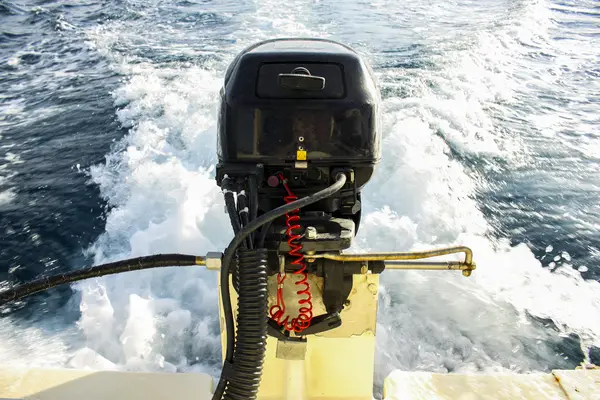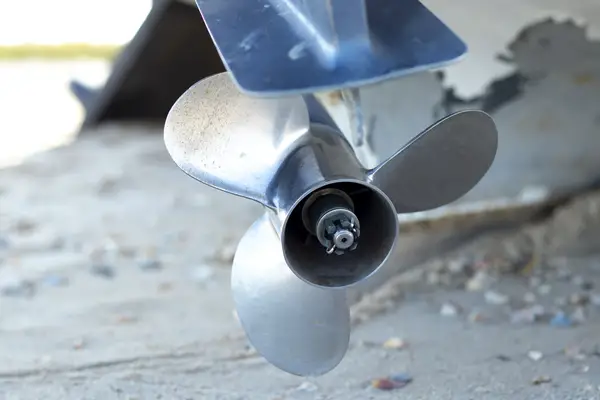Most sources of boat vibration at low speeds on your boat are related to the running gear or propulsion system.
When troubleshooting the source of boat vibration, it is helpful to approach the search methodically and inspect the most common causes first.
In this article, we will start at the prop, work our way up to the engine, and look at the factors that could be causing your boat’s vibrations.
Table of Contents
- What Is the Most Common Cause of Boat Vibration?
- Boat Vibration At Low-Speed Due To Outboard Motor
- Boat Vibration Due to Bent or Loose Shafts
- Inspect The Cutlass Bearing if Your Boat Vibrates
- Damaged and Loose Motor Mounts Can Cause Boat Vibrations At Low Speed
- How to Check Your Boat’s Engine Alignment
- Design Flaws That Cause Boat Vibrations
- Does Vibration on a Boat Cause Damage?
- Rounding Up The Most Common Reasons for Boat Vibration at Low Speed
What Is the Most Common Cause of Boat Vibration?
There are many reasons why your small boat may be having issues. According to the University of Washington, gas levels, engine problems, and propeller errors can all cause simple issues!
By far, the most common source of vibrations at low speeds is because of the prop. And, since it is fairly easy to diagnose visually, it’s a good place to start troubleshooting.

Any broken blades will cause dramatic vibrations, but even small nicks or gouges can be enough to disrupt the push of the water, causing your boat to run rough.
Usually, the damage is caused by running aground, hitting a partially submerged log, or debris. But weaknesses can develop, and propeller damage can appear without a precursor event.
Broken propellers are usually fixed with a replacement. However, if just one blade has been bent, a propeller shop may be able to restore the proper pitch.
Badly fouled props due to barnacles and marine growth will also cause a vibrating sensation. Fouled props will also be accompanied by a lower speed than expected at a given RPM and a reduced reaction time when turning.
A quick scrape to remove the barnacles is a quick and easy fix. Specially designed antifouling paints that are engineered to withstand the high speeds of a prop can extend the time between cleanings.
Boat Vibration At Low-Speed Due To Outboard Motor
Whether your boat has an inboard engine or an outboard motor, the most common sources of boat vibrations are the same–most likely stemming from the propeller, engine, or engine alignment.
The same methodical approach to troubleshooting can be applied.
Here are the most likely sources of boat vibration at a low speed from your outboard engine…

Inspection of the propeller is even easier with an outboard. Look at the spacing between the fin of your lower unit (closest to the propeller) and the blade of the propeller itself. Turn your prop and measure the distance for each blade.
If there is any variation in that distance for any of the blades, either the propeller has sustained damage or the prop shaft has been bent.
To be completely confident there is no debris caught in the hub, remove the propeller, and grease the shaft before replacing it.
If the prop and shaft are aligned, then the engine mounting bolts should be inspected for any looseness or shifting.
Once the most common sources—and easiest to diagnose—are eliminated, then it’s time to investigate the engine as the source.
The starting point for troubleshooting, especially if only experiencing vibrations at low RPMs or at idyl, would be to check the throttle and work outward from there.
Boat Vibration Due to Bent or Loose Shafts
If the propeller is clean and in good shape, the next source to investigate is the shaft.
A bent shaft is usually the result of either running aground or fouling a crab trap or lobster pot line in the prop. Even a thin fishing line tangled in the prop may put enough force on the running gear to cause a minor inflection in the shaft.
If the shaft is damaged, it will require removal. And, in most cases, replacement.
Another potential source of vibration could be from the shaft struts—the running gear that holds the prop after it leaves the boat through the cutlass bearing but before the propeller.
If there is free movement where the metal strut attaches to the fiberglass hull, the shaft will wobble, and it will cause a vibration.
Less commonly seen is what is referred to as “whipping.” Whipping is a sag in the shaft that forms from a combination of low use and insufficiently supported shaft system.
This is a design flaw that would bear investigation before replacing the bent shaft.
Inspect The Cutlass Bearing if Your Boat Vibrates
The cutlass bearing—the point where the shaft exits the hull into the water—can also be the source of vibrations.
There are two primary types of cutlass bearings. One allows for a small but steady stream of water to run past the shaft and into the boat. The other, a dripless cutlass bearing, recirculates water over the shaft allowing for a dry bilge.
Both styles allow water to flow over the shaft. With insufficient water flow, the shaft will become excessively hot while turning due to friction.
If either type of cutlass bearing is restricted too much, the excess heat will cause damage to the bearing (and possibly the shaft).
In addition, sand can get caught in the mechanism, causing damage to the bearing or wearing a groove into the shaft.
This type of damage is frequently seen after hauling a boat out to repaint the bottom. Pressure washing, sandblasting, sanding, and even just dusty boatyards can allow contaminants to get stuck in the fragile orifice.
Inspecting the bearing before putting the boat in the water is prudent.
While damage to the cutlass bearing or the shaft inside the cutlass bearing can lead to vibrations, it is also important to note that vibrations caused by prop damage or engine alignment problems can cause excess wear on the cutlass bearing and be a symptom, not the source of the problem.
Damaged and Loose Motor Mounts Can Cause Boat Vibrations At Low Speed
Another common source of boat vibration at low—and higher—speeds is a broken or loose motor mount. There is an incredible force on the mounts as the boat is rocked or jarred by large waves and wakes.
The motor mounts rest on strong rubber pads to absorb the shock of the boat’s motion and the engine’s motion. These can deteriorate. Or the bolts from the mount into the boat hull can become loose. The metal mounts themselves can crack.
Even just one loose motor mount will allow the shaft to wobble enough to cause a vibration. The effect can be especially noticeable when the engine is just starting and at lower RPMs.
How to Check Your Boat’s Engine Alignment
Once the prop and shaft are eliminated, then the engine itself becomes the possible source of vibration.
One of the most common sources of boat vibration is caused by an engine that needs alignment. The shaft must be perfectly lined up with the transmission and the damper plate of the engine.
Even a few thousandths of an inch off will put pressure on the internal workings of the transmission, place uneven pressure on cutlass bearings, and cause enough instability in the shaft to vibrate the boat.
You can check the alignment in the water by removing the four bolts that attach the shaft to the transmission. Gently slide the shaft down and back into place—pushing it snugly, and aligning the bolt holes again.
Then, use a feeler gauge—one can be purchased from an auto part or marine store—and run the three-thousandths of an inch (0.003) gauge between the two plates.
If the gap is too tight to run freely all the way around, the engine needs alignment. This is done by adjusting the motor mounts.
Other, less common, vibration sources stemming from the engine itself can be poorly aligned belt pulleys, bad injectors, loose mufflers, or other engine accessories. These cause the engine movement to exceed the amount the motor mounts can absorb.
Design Flaws That Cause Boat Vibrations

So far, we’ve explored sources that would cause a boat to start vibrating.
If you’ve always had a vibration on your boat, it could be that the propeller is too large and doesn’t have clearance between itself and the hull. The turbulence affects the prop wash.
Or another design flaw that could cause vibration is that the shaft is too long or not properly supported. A long overhang could cause a wobble in the shaft as it starts to push, causing the vibration sensation.
Does Vibration on a Boat Cause Damage?
Most sources of boat vibrations at low speeds can be diagnosed readily, and many are easy fixes.
However, leaving the problem unresolved can cascade into a variety of damage, from broken motor mounts to prematurely worn-out transmissions, so priority should be given to identifying and resolving the problem.
Rounding Up The Most Common Reasons for Boat Vibration at Low Speed
While there are several things that can cause your boat to irritatingly vibrate, here’s a quick recoup of the most likely reasons:
- Damaged propeller (inboard or outboard motors)
- Damaged propeller shaft (inboard or outboard motors)
- Cutlass bearings (inboard motors)
- Engine mounts or alignment (inboard or outboard motors)
- The engine is in need of maintenance or service (inboard or outboard motor)
Takeaway Tip: Always start with the most likely culprit, the prop!

Growing up in Florida, I’ve been surrounded by saltwater my entire life…and I love sharing my passion with others.
To learn more about why I started Saltwater Mecca, visit the ABOUT page.
Thank you for reading this article. Browse around & have some fun!